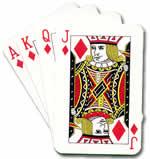Cunning card trick
Problem

Look at the top card and place it face down on the table. Starting with one more than the value of the card (counting Ace as 1, Jack as 11, Queen as 12 and King as 13), count out cards on top of it until you reach 13.
For example, if the top card is a 7, place it face down on the table and then deal 6 cards face down on top of it, counting "8, 9, 10, 11, 12, 13". Of course, if the first card is a king you won't need any extra cards.
Look at the next card, place it face down on the table next to
the first pile and do the same thing.
Repeat until you have used all the cards in the pack and have a row
of small piles of cards on the table.
If you run out of cards before you complete the final pile, keep
the cards from that pile to one side to start your magic counting
pile.
Now gather up all but three of the piles and add them to your
magic counting pile.
(If you don't have one yet, these will form the pile.)
Choose one of the three remaining piles to be the secret
pile.
Look at the bottom cards of the two remaining piles and add their
values.
(So if, for example, the bottom cards are a Jack and a two, you get
11+2 =13.)
Count out that number of cards from your magic counting pile.
Now count out 10 more cards from the magic counting pile.
Finally, count how many cards are left in the magic counting pile, and look at the bottom card of the secret pile.
What do you notice?
Try again. If you like, you could use this trick to impress friends and relatives!
Can you explain how this delightful trick works?
Getting Started
When you carry out this trick, you make lots of piles on the table, but you only keep three.
Are the others important to the problem, or can you ignore them when you are trying to understand how the trick works?
Student Solutions
Well done Sara and Terence for cracking this
Cunning Card Trick.
Sara started:
Of the three piles, take the three bottom cards to be $x$, $y$ and $z$.
In the $x$ pile there will be $13 - x + 1$ cards.
This is because whatever the value of $x$, you counted on to $13$, (if $x = 7$ you count 8, 9, 10, 11, 12, 13 (6 cards)) but you also have the $x$ card which is why you add 1 more.
So an $x$ value of $7$ gives you $7$ cards in the pile, $8$ gives you $6$, queen gives you $2$, etc.
So pile $x$ contains $14 - x$ cards, pile $y$ contains $14 - y$ cards and pile $z$ gives you $14 - z$ cards."
Using the fact that there are 52 cards in a pack, Terence finished off the argument as follows:
"So, we have in total $42 - (x + y + z)$ cards in the piles, and so $10 + x + y + z$ cards in the magic counting pile.Suppose we deal y and z cards out, there will be just $10 + x$ cards left in the magic counting pile.
Dealing a further 10 leaves $x$ cards, which is the value of the bottom card of the secret pile!
Secret revealed!!!"
Alexander and James from The Batt Primary School, Witney have just sent us this solution
Many thanks for such a clear explanation.
Teachers' Resources
We are often intrigued by card tricks.
Is it magic or is there an explanation?
Perhaps mathematics can come to the rescue!
